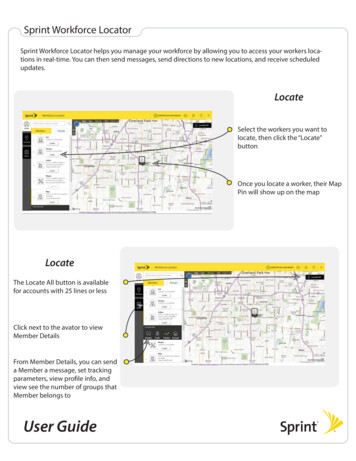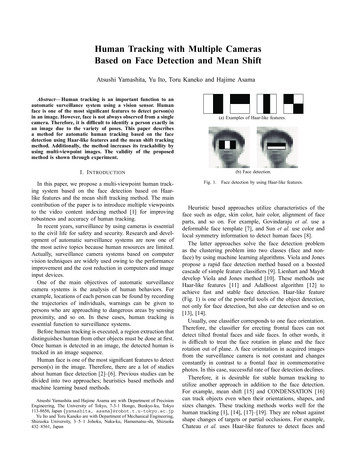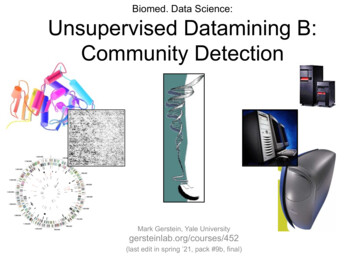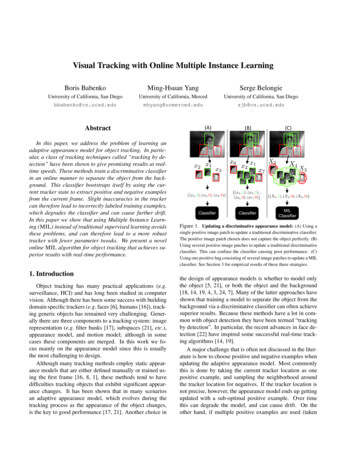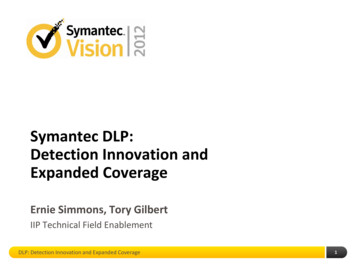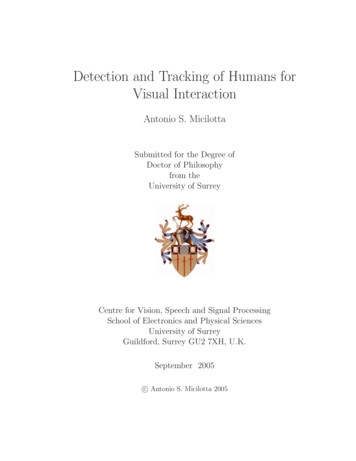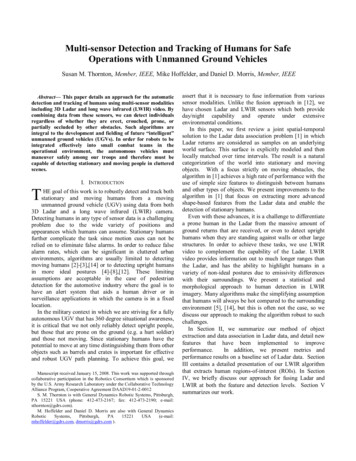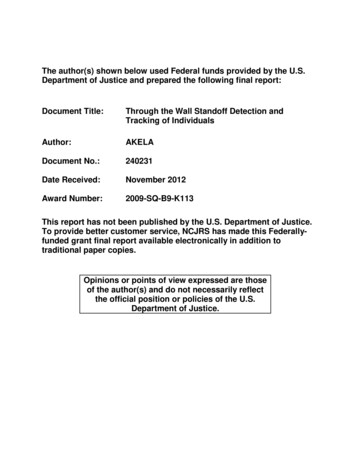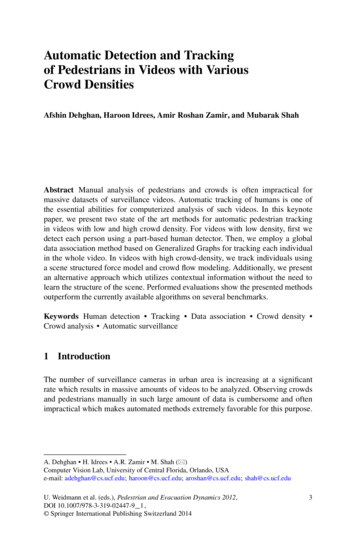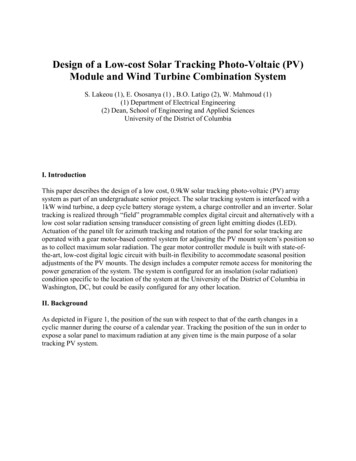
Transcription
DETECTION AND TRACKING OF MULTIPLE HUMANS INHIGH-DENSITY CROWDSbyIrshad AliA research study submitted in partial fulfillment of the requirements for thedegree of Master of Engineering inComputer ScienceExamination Committee:Dr. Matthew N. Dailey (Chairperson)Dr. Manukid Parnichkun (Member)Dr. Nitin V. Afzulpurkar (Member)Nationality: PakistaniPrevious Degree: Bachelor of Science in Computer EngineeringSamara State Technical University, RussiaScholarship Donor:Higher Education Commission (HEC), Pakistan - AITFellowshipAsian Institute of TechnologySchool of Engineering and TechnologyThailandMay 2009i
AcknowledgmentFirst of all I thank to my advisor Matthew Dailey for his continuous support in mymaster research study. He was always there to give advice and listen to my problems.I learnt from him how to do research and he showed me how to be persistent toaccomplish any goal.Besides my advisor I would like to thank to my committee members Nitin Afzulpurkarand Manukid Parnichkun for their valuable suggestions, encouragement and constructive criticism.I would like to thank Higher Education of Pakistan (HEC) for providing me financialsupport throughout my studies at AIT.I would like to thank to all my friends for their support and assistance during mystudies. Last, but not least I thank my family for their unconditional support andencouragement.ii
AbstractAs public concern about crime and terrorist activity increases, the importance of publicsecurity is growing, and video surveillance systems are increasingly widespread toolsfor monitoring, management, and law enforcement in public areas. The visual surveillance system has become popular research area in computer vision. There are manyalgorithms exists to detect and track people in video stream. Human detection andtracking in high density crowds where object occlusion is very high is still an unsolvedproblem. Many preprocessing techniques such as background subtraction are fail insuch situations.I present a fully automatic approach to multiple human detection and tracking in highdensity crowds in the presence of extreme occlusion. We integrate human detection andtracking into a single framework, and introduce a confirmation-by-classification methodto estimate confidence in a tracked trajectory, track humans through occlusions, andeliminate false positive detections. I search for new humans in those parts of each framewhere humans have not been detected previously. I increase and decrease the weight oftracks through confirmation-by-classification process. This is helpful to remove thosetracks (false positives) which not confirmed for long time. I keep the tracks which havenot been confirmed only for a short period of time, to give chance to those tracks wherehuman are occluded fully or partially for a short period of time to rejoin their tracks.We use a Viola and Jones AdaBoost cascade classifier for detection, a particle filer fortracking, and color histograms for appearance modeling.An experimental evaluation shows that our approach is capable of tracking humans inhigh density crowds despite occlusions. On a test set with 35.35 humans per imageachieves 76.8% hit rate with 2.05 false positives per image and 8.2 missed humans perimage. The results form a strong basis for farthar research.iii
Table of ContentsChapterTitlePageTitle PageAbstractTable of ContentsList of FiguresList of wProblem StatementObjectivesLimitations and ScopeResearch OutlineLiterature Review2.12.22.32.42.53iiiiivvvii4Object DetectionHuman Detection in CrowdsTracking Pedestrians in CrowdsPedestrian CountingPedestrian ystem OverviewClassifier TrainingHead DetectionHuman TrackingExperiments and Results254.1 Overview25Conclusion and Recommendation295.1 Conclusion5.2 Contribution5.3 Recommendations292929References31iv
List of geExample of a large crowd. People are walking in both directions along the road near the Mochit light rail station inBangkok, Thailand. This picture shows the extreme occlusionof the pedestrians bodies.Another example of a large crowd. People are standing andwalking in both direction along the road near the Mochitlight rail station in Bangkok, Thailand. There are some othermoving objects (cars) also in the scene.Another example of a large crowd. In this scene people arewalking in both directions along the road near the Mochitlight rail station. One person on a motorcycle is moving fasterthan the rest of the crowd.Example rectangle features in a detection window. The feature value is equal to the difference of the sum of the pixelintensities inside the white rectangles and black rectangles.(a) Two-rectangle features. (b) Three-rectangle feature. (c)Four-rectangle feature. Reprinted from Viola and Jones (2001b).Viola and Jones integral image. (a) The integral image valueis the sum of pixel values from the top-left corner of the imageto the location (x, y). (b) An example of using integral imagevalues to compute the sum of the intensities inside region D.The value at position 1 is the sum of pixel values in rectangular region A. The value at position 2 is sum of pixel valuesin rectangular regions A and B. The value at 3 is sum of pixelvalues in rectangular regions A and C. The value at position4 is sum of pixel values in rectangular regions A, B, C and D.The sum within rectangle D can be computed as 4 1-(2 3).Reprinted from Viola and Jones (2001b).Structure of a cascade. Reprinted from Viola and Jones (2001b).Challanges in contour-based object detection. (a) Good contrasted image. (b) Detected contours of image shown in (a).(c) Poor contrasted image. (d) Detected contours of imageshown in (b). Reprinted from Schindlera and Suterb (2008).Pedestrian detection using background subtraction. (a) Asample frame . (b) Results of background subtraction. Reprintedfrom Zhao, Nevatia, and Wu (2008).Head and shoulder detection. (a) Heads detected from foreground boundaries. (b) Ω–shape head and shoulder model.Reprinted from Zhao et al. (2008).Edgelet features. Reprinted from Wu and Nevatia (2007).v2225567789
2.82.92.102.112.123.13.23.33.43.53.64.1Body part based detection system. (a) Spatial relations between body parts. (b) Tracking example using body partbased detection. Reprinted from Wu and Nevatia (2007).Pedestrian detection based on local and global cues. Reprintedfrom Leibe, Seemann, and Schiele (2005).Human tracking using a 3D shape model. (a) Ellipsoid-based3D human shape model. (b) A tracking example using thehuman shape model. Reprinted from Zhao et al. (2008).Pedestrian counting. (a) Perspective map. (b) An exampleof people counting. Red and green tracks show the flow ofpeople walking towards or away from the camera. Reprintedfrom Chan, Liang, and Vasconcelos (2008).Sample pedestrian behaviors. (a) Two people fighting. (b)Overcrowding. (c) Blocking an area. (d) A person jumpingover a barrier. Reprinted from Cupillard, Avanzi, Bremond,and Thonnat (2004).System overview.The main concept of Adaboost.Some example positive images used to train the head classifier.Some example negative images used to train the classifier.Block diagram of the tracking algorithm. D is the distancebetween a newly detected head and a the nearest predictedlocation, C is threshold (in pixels) less than the width of thetracking window, and a is a constant, a 0 1.The figure shows the tracking error and detection response inconsecutive frames. Red rectangle represent tracking windowand green rectangle shows the detection.Tracking results on real video frames. Red rectangles indicatedetections, and green rectangles indicate actual head positions in the frame.vi91011141517181819212427
List of TablesTable4.14.24.3TitlePageTraining Parameters.Head Detection Parameters.Tracking Results.vii262828
Chapter 1Introduction1.1OverviewAs public concern about crime and terrorist activity increases, the importance of publicsecurity is growing, and video surveillance systems are increasingly widespread tools formonitoring, management, and law enforcement in public areas. Since it is difficult for humanoperators to monitor surveillance cameras continuously, there is a strong interest in automatedanalysis of video surveillance data. Some of the important problems include pedestriantracking, behavior understanding, anomaly detection, and unattended baggage detection. Inthis research study, I focus on pedestrian tracking.There are many commercial and open source visual surveillance systems available in themarket but these are manual and need additional resources such as human operators toobserve the video. This not feasible in high density crowds, where observing the motion andbehavior of humans is a very difficult and boring job, making it error prune.Automatic pedestrian detection and tracking is a well-studied problem in computer visionresearch, but the solutions thus for only able to track a few people. Inter-object occlusion, selfocclusion, reflections, and shadows are some of the factors making automatic crowd detectionand tracking difficult. I will discuss these issues in chapter 2 in more detail.The pedestrian tracking problem is especially difficult when the task is to monitor and managelarge crowds in gathering areas such as airports and train stations. There has been a greatdeal of progress in recent years, but still, most state-of-the-art systems are inapplicable tolarge crowd management situations because they rely on either background modeling, bodypart detection, or body shape models. These techniques make it impossible to track largenumbers of people in heavily crowded scenes in which the majority of the scene is in motion(rendering background modeling useless) and most of the human’s bodies are partially orfully occluded. Under these conditions, we believe that the human head is the only bodypart that can be robustly detected and tracked, so in this research study I present a methodfor tracking pedestrians by detecting and tracking their heads rather than their full bodies.In this research study I propose, implement, and evaluate a large scale human tracking system,which can detect and track humans in large crowds.1.2Problem StatementPedestrian detection and tracking in large crowds such as those shown in Figures 1.1, 1.2,and 1.3 is still an open problem.In high-density crowds some popular techniques such as background subtraction fail. Wecannot deal with this problem in ways similar to simple object tracking, where the number1
Figure 1.1: Example of a large crowd. People are walking in both directions along theroad near the Mochit light rail station in Bangkok, Thailand. This pictureshows the extreme occlusion of the pedestrians bodies.Figure 1.2: Another example of a large crowd. People are standing and walking inboth direction along the road near the Mochit light rail station in Bangkok,Thailand. There are some other moving objects (cars) also in the scene.Figure 1.3: Another example of a large crowd. In this scene people are walking in bothdirections along the road near the Mochit light rail station. One personon a motorcycle is moving faster than the rest of the crowd.2
of objects is not large and mosts part of the object are visible. Inter-object occlusion and selfocclusion in crowd situations makes detection and tracking challenging. In such situations wealso cannot perform segmentation, detection, and tracking separately. We should consider itas single problem.We have four main challenges during crowd detection and tracking: Inter-object occlusion: a situation in which part of the target object is hiddenbehind another. Inter-object occlusion becomes critical as the crowd density increases.In very high-density crowds, most of an object’s parts may not be visible. Self occlusion: sometimes a object occludes itself, for example when a person talks ona mobile phone, the phone and hand may hide part of the head. This type of occlusionis more temporary and sort term. Size of the visible region of the object: as the density of a crowd increases, thesize of the visible region of the object decreases. Detecting and tracking this object ina dense situation is very difficult. Appearance ambiguity: when target objects are small, then appearance tends to beless distinguished.1.3ObjectivesThe main objectives of this research study are as follows:1. To develop a method to detect and track humans in a crowded video in the presenceof extreme occlusion.2. Evaluate the performance of the system on real videos.1.4Limitations and ScopeFor successful detection and tracking, I require that at least the head must be visible. I assumea stationary camera so that motion can be detected by comparing subsequent frames.1.5Research OutlineThe organization of this research study is as follows. Chapter 2 describes the literaturereview, chapter 3 describes the methodology, chapter 4 describes the experiments and resultsand chapter 5 conclusion and recommendation.3
Chapter 2Literature ReviewIn this chapter I review existing methods for handling crowd scenes. The chapter is dividedinto five parts, according to the targets and applications:1. Object Detection2. Human Detection in Crowds3. Tracking Pedestrians in Crowds4. Pedestrian Counting5. Crowd Behavior2.1Object DetectionObject detection in images is a challenging problem for computer vision; many approachesbased on features and shape exist. The problem becomes more difficult in the case of highdensity crowds where full visibility of the target cannot be guaranteed, and inter-objectocclusion produces ambiguity of object appearance and shape.The Viola and Jones (2001b, 2001a) approach is a very popular real time object detectiontechnique. They use feature-based object detection. They tested their method on face detection. They used 4916 hand-labeled faces scaled and aligned to a base resolution of 24 24 pixels and 10,000 non-face (negative images) of size 24 24 pixels to train their classifier.On a test set containing 130 images and 507 faces, they achieved a 93.7% detection rate with422 false detections.A short description of the Viola and Jones approach is given below.1. They compute an image feature using an integral image, which is very simple andquick to compute. There are three types of features: two-rectangle, three-rectangle,and four-rectangle. A feature’s value is equal to the difference of the sum of whiterectangles and black rectangles as shown in Figure 2.1. The integral image value atlocation (x, y) can be computed from the following equation.Xii(x, y) i(x0 , y 0 )x0 x,y 0 ywhere i(x0 , y 0 ) is the pixel intensity value at location (x0 , y 0 ). The procedure for computing the integral image value at any location (x, y) in an image is shown in Figure2.2.2. They learn classifiers based on AdaBoost. AdaBoost selects a small number of weakclassifiers based on image features and produces a strong classifier.4
(a)(b)(c)Figure 2.1: Example rectangle features in a detection window. The feature value isequal to the difference of the sum of the pixel intensities inside the whiterectangles and black rectangles. (a) Two-rectangle features. (b) Three-rectangle feature. (c) Four-rectangle feature. Reprinted from Viola andJones (2001b).(a)(b)Figure 2.2: Viola and Jones integral image. (a) The integral image value is the sumof pixel values from the top-left corner of the image to the location (x, y).(b) An example of using integral image values to compute the sum of theintensities inside region D. The value at position 1 is the sum of pixel valuesin rectangular region A. The value at position 2 is sum of pixel values inrectangular regions A and B. The value at 3 is sum of pixel values inrectangular regions A and C. The value at position 4 is sum of pixel valuesin rectangular regions A, B, C and D. The sum within rectangle D can becomputed as 4 1-(2 3). Reprinted from Viola and Jones (2001b).3. The weak learning algorithm, at each iteration select the feature that performs best inclassifying the training set in terms of weighted error rate. The algorithm calculates athreshold for each feature.4. Finally they combine multiple strong classifiers into a cascade to discard backgroundregions (negative images) quickly. Each element of the cascade contains a strong classifier combining multiple weak classifiers by weighted voting. A positive result from thefirst classifier will be passed to second classifier, and positive results from the secondwill be passed to third classifier, and so on, as shown in Figure 2.3.The Viola and Jones technique is one example of a feature-based technique. Another majorcategory of object detection technique is the category of shape-based techniques. As anexample Schindlera and Suterb (2008) perform object detection using shape-based method.They achieve 83-91% detection rate at 0.2 false positives per image with average processing5
Figure 2.3: Structure of a cascade. Reprinted from Viola and Jones (2001b).time of 6.5 seconds for 480 320 pixels size image. They first extract contour points ofan object to represent the object shape. They propose a distance measure to compare acandidate shape to an object class template. Image contrast, reflection, and shadows are themain problems for using these kind of algorithms, as shown in Figure 2.4.I select feature-based technique because it performs well in crowded scene where objectboundaries are not clear, and it is very fast compare to the shape-based technique.2.2Human Detection in CrowdsThe objective of human detection in crowds is to detect the individuals in a crowded scene.Many computer vision algorithms have been developed for this task. Success depends on thedensity of crowd; for example in high-density crowds, where occlusion is high and bodies arenot visible, many algorithms based on the human body fail. If the crowd density is low andocclusion is partial or temporary then these algorithms work well. In the following sectionsI discuss these algorithms in more detail.2.2.1Background SubtractionBackground modeling is a very common technique in tracking, and almost all previous workuses background modeling to extract the foreground blobs from the scene. See Figure 2.5for an example. As mentioned before, the previous work in crowd tracking is limited to afew people. When the crowd is large, there may be so many individuals that backgroundsubtraction fails to find meaningful boundaries between objects.6
(a)(b)(c)(d)Figure 2.4: Challanges in contour-based object detection. (a) Good contrasted image.(b) Detected contours of image shown in (a). (c) Poor contrasted image.(d) Detected contours of image shown in (b). Reprinted from Schindleraand Suterb (2008).(a)(b)Figure 2.5: Pedestrian detection using background subtraction. (a) A sample frame .(b) Results of background subtraction. Reprinted from Zhao et al. (2008).7
(a)(b)Figure 2.6: Head and shoulder detection. (a) Heads detected from foreground bound-aries. (b) Ω–shape head and shoulder model. Reprinted from Zhao et al.(2008).2.2.2Head DetectionIn high-density crowds, the head is the most reliably visible part of the human body. Manyresearchers have attempted to detect pedestrians through head detection. I review this approach here.Zhao and colleges (Zhao, Nevatia, & Wu, 2008; Zhao, Nevatia, & Lv, 2004) detect headsfrom foreground boundaries, intensity edges, and foreground residue (foreground region withpreviously detected object regions removed). See Figure 2.6 for an example. These algorithmswork well in low-density crowds but are not scalable to high-density crowds.Wu and Nevatia (2007) detect humans using body part detection. They train their detectoron examples of heads and shoulders, and other body parts. Their target is to track partiallyoccluded people. In high-density crowds the visibility of the head and shoulder cannot beguaranteed. The method works well in low density crowds in which the humans are isolatedin such a way that at least their heads and shoulders are visible.Sim, Rajmadhan, and Ranganath (2008) use the Viola-type classifier cascades for head detection. The results from the first classifier are further classified by the second classifier, whichis based on color bin images. The color bin images created from normalized RG histogram ofresulting windows from first classifier. Their main objective is to reduce the false positives ofthe first Viola-type head detector using color bin images. They reduced the false alarm ratefrom 35.9% to 23.9%, but the detection rate also decreased from 87.3% to 82.5%.This approach is only good for head detection; for tracking the detection rate is more important than the false positive rate. We can reduce/eliminate false positives during tracking,but if we miss detection than there is no way to recover those missing heads during tracking.2.2.3Pedestrian DetectionPedestrian detection in which the entire pedestrian bodies of target humans are detected,is also an interesting topic. There are several existing solutions using different approaches.8
Figure 2.7: Edgelet features. Reprinted from Wu and Nevatia (2007).(a)(b)Figure 2.8: Body part based detection system. (a) Spatial relations between bodyparts. (b) Tracking example using body part-based detection. Reprintedfrom Wu and Nevatia (2007).The main problem in pedestrian detection is occlusion, which again depends upon the size ofcrowd. If the crowd density is high then correct detection of pedestrians is still not possible.Andriluka, Roth, and Schiele (2008) combine detection and tracking in a single framework.To detect pedestrians they use a part-based object detection model. The algorithm detectsall pedestrians in every frame. In their approach, the human body is represented by theconfiguration of the body parts. The articulation of each pedestrian is approximated in everyframe from body parts or limbs. The main objective of part based detection algorithms is totrack in partially occluded situations, such as pedestrians crossing each other on a walkway.Wu and colleagues (Wu & Nevatia, 2007; Wu, Nevatia, & Li, 2008) use a body part detectorapproach. They introduce edgelet features in their work. An edgelet is a short segmentof a line or a curve as shown in Figure 2.7. They learn the body part detector based onedgelet features using a boosting method. The response from all detectors is combined usinga joint likelihood model. Their system took average of 2.5 to 3.6 seconds per image. Thesealgorithms are slow. We cannot apply the body part detector concept in high-density crowdsbecause the body parts are usually not visible.Zhao et al. (2008, 2004) use previously discussed head detection technique to generate initial9
Figure 2.9: Pedestrian detection based on local and global cues. Reprinted from Leibeet al. (2005).human hypotheses. They use a Bayesian framework in which each person is localized bymaximizing a posterior probability over location and shapes, to match 3D human shapemodels with foreground blobs. They handle the inter-object occlusion in 3D space. The 3Dhuman shape model is a good approach to handle the occlusion problem but we cannot usethis approach in high-density crowds because in high-density crowds the human body is oftennot visible.Leibe et al. (2005) integrate evidence over multiple iterations and from different sources.They generate pedestrian hypotheses and create local cues from an implicit shape model(Leibe, Leonardis, & Schiele, 2004), which is a scale-invariant feature used to recognize rigidobjects. To enforce global consistency, they add information from global shape cues. Finally,they combine both local and global cues. Their system detects partially occluded pedestriansin low density crowds. See Figure 2.9 for an example.2.3Tracking Pedestrians in CrowdsTracking is one of the most researched areas of computer vision. In the case of pedestriantracking, the focus of the all the previous research has been to estimate velocity, identifythe object in consecutive frames, and so on. The previous work does not consider denseenvironments. This is why all previous tracking algorithms are limited to few people.As previously discussed, occlusion occurs very frequently when there are many objects orhumans moving in the scene. Long, permanent, and heavy occlusions are the basic problemsof pedestrian tracking in crows.2.3.1LikelihoodWhile tracking objects from one frame to another frame we search for the objects in the nextframe. In Bayesian approach, to perform this search, we compute the likelihood (based on10
(a)(b)Figure 2.10: Human tracking using a 3D shape model. (a) Ellipsoid-based 3D humanshape model. (b) A tracking example using the human shape model.Reprinted from Zhao et al. (2008).appearance, shape and so on) of the object in the next frame. I review this approach here.Zhao et al. (2004, 2008) propose a 3D human shape model and color histograms for trackingpeople in crowds, as shown in Figure 2.10. As previously discussed, they first locate headpositions and then estimate ellipsoid-based human shape. They combine both detection andtracking in single step. They compute joint likelihood of objects based on appearance, anduse Bayesian inference to propose human hypotheses in next frame. Their algorithm is oneof best algorithms for tracking people and their experiments include the largest crowd everused, but the algorithm is still limited to 33 people. This idea to consider 3D space is goodfor crowd situations. Using 3D models, we can reduce false positives and solve inter-objectocclusion problems easily. However, we cannot use the human shape model in high-densitycrowds.Wu and Nevatia (2006) track humans using their previously discussed body part detector. Intheir approach, the human body is the combination of four parts (full-body, head-shoulder,torso, and legs) as shown in Figure 2.8. In their approach they detect static body parts ineach frame. The detection results are then input to a tracking module, which tracks fromone frame to another. They compute the likelihood from appearance model based on colorhistogram and dynamic model based on detection response. This approach is good for robusttracking in case of partial occlusion but cannot apply in high density crowds.Ramanan, Forsyth, and Zisserman (2007) first build a puppet model of each person’s appearance and then track by detecting those models in each frame. To build the model theyuse two different methods. In the first method, they look for candidate body parts in eachframe, then cluster the candidates to find assemblies of parts that might be people, while thesecond method looks for entire people in each frame. They assume some key poses and buildmodels from those poses. In their approach they do not detect the pedestrian body, but theybuild the body model based on appearance and calculate the likelihood based on this modelin next frame. This approach is good for situations in which we have to deal with differentposes of humans such as dancing, playing, and so on. I consider only standing and walkingpeople.Mathes and Piater (2005) obtain interest points using the popular color Harris corner detector. They build a model describing the object by a point distribution model. Their model11
is somewhere between active shape models (Cootes, Taylor, Cooper, & Graham, 1995) andactive appearance models (Cootes & Taylor, 2004). These are statistical models based onshape and appearance. They are used to describe the object in images, and later we can usethem to match in another image. This algorithm requires a predefined region of interest. Incase of large crowd it may be a better choice to select such features to track, rather than theentire object.2.3.2Multiple Object TrackingTracking people in crowds is a specific case of the more general problem of multiple objecttracking. Multiple object means the distribution of objects in the scene and their dynamicswill be nonlinear and none-Gaussian. One of the most popular technique for nonlinear, noneGaussian Bayesian state estimation is the particle filter or sequential Monte Carlo (Doucet,Freitas, & Gordon, 2001) method. The particle filter technique is also known as CONDENSATION (Isard & Blake, 1998b, 1998a). To use a particle filter we need to define objectsbased on shape (i.e. contours), appearance models or features.Ma, Yu, and Cohen (2009) consider the multiple target tracking problem as maximum aposteriori problem. A graph representation is used for all observations over time. They useboth motion and appearance likelihoods and formulate the multiple target tracking problemas the problem of finding multiple optimal paths in the graph. When we apply segmentationon a cultured scene the object region is mixed with other foreground regions and one foreground region may correspond to multiple objects. To solve this problem, they generate newhypotheses to measure the graph from merge, split and mean shift operations.Yang, Duraiswami, and Davis (2005) use color and edge orientation histogram features totrack multiple objects using a particle filter.The actual CONDENSATION algorithm shows poor performance when the object are occluded or the objects are too close to each other. To overcome these problems Kang and Kim(2005) use the competition rule. In this way they separate the the objects which are closeto each other. In their approach, they use self-organizing map algorithm to build the humanshape from the body outlines. To track the people from frame to frame they use HiddenMarkov Model.Since the original particle filter was designed to track single object, Cai, Freitas, and Little(2006) modify the particle filter algorithm for multiple target tracking. They define thetrajectories in first frame, find nearest neighbor in next frame and associate them with existingtrajectories. To solve the occlusion problem they stabi
tracking, and color histograms for appearance modeling. An experimental evaluation shows that our approach is capable of tracking humans in high density crowds despite occlusions. On a test set with 35.35 humans per image achieves 76.8% hit rate with 2.05 false positives pe
